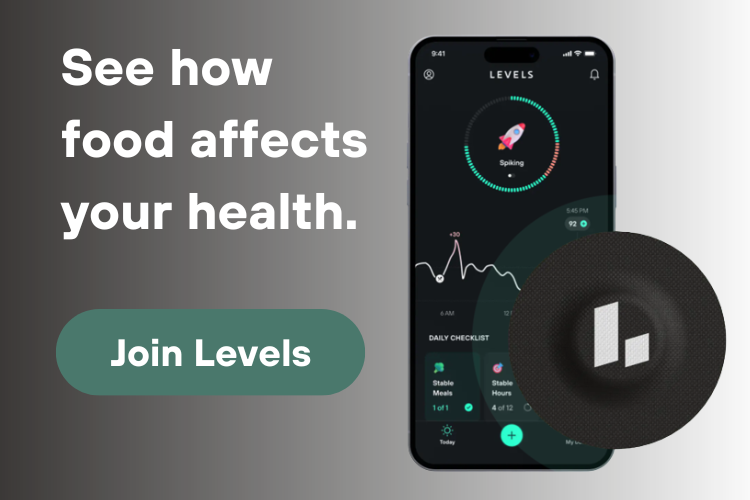Figuring out your core business model is one of the biggest challenges of growing a company. That’s especially true when your business affects people’s health, and profit motives can create incentives for your business that are misaligned with your customers’ needs.
At Levels, our mission is to solve the metabolic health crisis. We want to empower our customers to live healthier lives. So we set out to find a business model that aligns our incentives with the health and happiness of our members.
Incentives are essential to understand when building your business model because incentives drive decisions, whether intentional or not. As Warren Buffet’s business partner Charlie Munger puts it, “Show me the incentive, and I will show you the outcome.” Business models misaligned with customers’ interests encourage dark patterns and shady business practices. Any entity that has misaligned incentives will fail in the long run — or at the very least, operate in an antagonistic way towards its customers.
For example, upselling is an acute problem in healthcare today. Doctors and hospitals have an incentive to push people into more testing, more surgery, more drugs, more treatments — even if those treatments don’t lead to better outcomes. There are many reasons for this overtreatment, including the fact that moving more products and procedures is how the business makes money.
We don’t ever want to feel forced to push hardware and services on customers just to maximize profit.
One of our incentives will always be growing our revenue, but we want to avoid doing so at the expense of our customers. (At least not at a cost that is greater than the value we’re providing back to them.) We want to avoid developing a business model that sets us up for failure — not just financially but also in our commitment to our members. By finding a business model that aligns our incentives with the health of our customers, everybody wins.
We think that model is membership. That’s why we’re moving forward with a new structure where customers pay an annual fee to become a Levels member and gain access to purchase products and services to improve their health at or near cost. (Think, like Costco — more on that below.)
In this article, we’ll explore other models we considered and the dark patterns they incentivized, why membership felt like the right path forward, and how we envision this new model benefitting our customers, our business, and the health of the world at large.
Note for existing customers: Any customer who purchased Levels before the end of 2021 is granted membership until the end of 2022 without any additional charge. Anybody who purchases in 2022 will be granted membership for one year from the date of purchase. The current price of the annual membership is $199, and the price for 28 days of CGMs is $199.
The Dark Patterns We Want to Avoid
When we embarked on this exploration of business models, we quickly saw a lot of dark patterns in the business world that we wanted to avoid. For those unfamiliar with the term, dark patterns are anything designed to put shareholder value ahead of customer value.
Most business models require companies to sell more products consistently. At best, this forces businesses to constantly develop and market new products to new customers — rather than making the experience for existing customers the best it can be. Pharmaceutical companies are great examples of this: They need to keep selling more stuff to stay above water, so they have no incentive to focus on long-term value for those who have already made a purchase.
At worst, the sell-more-to-make-more model leads to businesses tricking customers into thinking they need more products or services than they do. If you’ve ever been to an auto repair shop, you’re probably familiar with this dark pattern (and how horrible it feels as a customer). If an expert says, “You need to replace your brake fluid,” who are you to disagree? Meanwhile, these “service advisors” are almost always compensated with commission. They’re strongly encouraged to advise people to get unnecessary services to increase revenue, and often given bonuses based on their percentage of high-margin upsells, like fluids. The business incentive to make more money by selling more services isn’t aligned with creating a trustworthy and fair customer experience.
Upselling is especially a problem in the medical system, where people are pushed into additional testing and procedures that they don’t need because that’s how the providers make money. If we remove this as a revenue incentive for ourselves, we can better align our company with the long-term health of our members.
Subscriptions are another common business model today. While subscriptions may seem like a membership, not all subscriptions are memberships; in fact, the two can have wildly different incentive structures. Membership implies that there will be an ongoing three-way relationship between the member, the company, and its community, where the member’s participation helps the product and community continuously evolve and improve. Most subscriptions are generally a one-way relationship where customers pay to receive a service or product. It’s mostly a transactional relationship.
The need to reduce churn to succeed as a subscription does create positive incentives for a business to improve the customer experience. Still, it often leads to dark patterns that make it hard for customers to separate themselves from the company. For example, certain prescription medicine companies sell direct-to-consumer on a subscription basis. Because their business incentive is to keep customers buying medicine from them month after month, they’ve done things like making it hard to cancel and hiding your prescription so you can’t fill it elsewhere.
We could see how a subscription model for our products wouldn’t align our needs with the long-term health of our customers. Instead, we wanted to find a model where we could support the long-term metabolic health of people, whether or not they continuously use CGMs or other products we may offer in the future.
Even certain types of memberships can cause misaligned incentives, particularly those that offer one monthly fee for “all you can eat” use of the product or service. This business structure makes every person who uses the product a cost center — and makes the most engaged customers the costliest. Gym memberships are a great example: Gyms count on the fact that a large percentage of their members will pay and then barely use the facilities. Like subscriptions, they make it hard to cancel — even if you’re not using the service — because they bank on that absentee behavior to make money.
These incentives feel obviously misaligned. We wanted to avoid a situation where we view our power customers — likely the people happiest with the product and our most prominent advocates — as a problem. To improve the health of our members and the world at large, we need people to actually use our products.
Our goal was to find a business model that avoids these dark patterns and makes the “easy path” aligned with our members’ interests while also allowing us to succeed as a company.
The Magic That Happens When Memberships Work
Costco is an excellent example of a business model that successfully aligns the incentives of the business and its members. Many people don’t realize that Costco is a membership business, not just a wholesaler.
A substantial portion of Costco’s profit comes from its annual membership fees. Costco operates what people think of as their core business (selling goods) close to profit-neutral — they only charge about 10% margins on the products they sell, and that’s just enough to cover the other costs of doing business.
Let’s explore how this works out so well for both the business and its customers. To make money, Costco is incentivized to attract more members and to make their members love the brand so much that they keep paying year after year (and, ideally, tell everyone they know about how great it is, ergo helping attract more members). It doesn’t matter whether they come in and shop every week or just a couple of times a year. Costco employees don’t need to push customers to buy more things for the business to make more money. In other words, Costco’s business success is only dependent on its members’ happiness. The results speak for themselves: Costco’s annual membership renewal — which is a good indication of their happiness — is an impressive 90%.
Exactly how do they keep members happy? First and foremost, they provide customers with incredible value for their membership. They negotiate intently with suppliers in exchange for volume, and since they don’t inflate the margins on the products, they’re able to provide some of the lowest prices on the market. Because of this, customers who shop there regularly get far more than their $60 membership fee back each year in savings (at virtually no additional cost to the business). Their high membership and sales numbers give Costco more influence with suppliers to source more great products at great prices, leading to a flywheel of more members, higher sales, more leverage, lower prices, and on and on.
But for Costco to keep members happy and create this flywheel, it has to deliver one more thing that often goes overlooked: trust. At Costco, that means trust that the products they sell aren’t inexpensive because they are low quality. Since Costco isn’t incentivized to squeeze out extra margin and cut corners on product quality, their Kirkland Signature products are incredibly high quality. In almost every vertical with a Kirkland Signature product, that product is the industry leader in quality (e.g., olive oil, diamonds), often at a fraction of the price. All in all, customers trust that they’ll be able to find high-quality products at great prices when they shop at Costco.
Stepping back and thinking about why people join and remain a member of a group, it’s the value the group creates for them throughout the membership. From the members’ perspective, value creation has three main components: The actual value that they receive, awareness and perception of that value, and how the cost of the membership (both in terms of price, time, and effort that it takes to be part of the group) compares to the perceived value. When operating under this model, a business must consider how every action creates value for the member and raises awareness of the value, so the perceived value minus cost equation remains positive.
Without trust, even if a company creates value, it would be very difficult for members to believe and follow a company’s recommendation to buy their products, establishing a self-perpetuating negative value creation loop. (If customers never use their membership because they don’t trust it, they’ll never see value from it.) This is why, when making business, product, design, and operations decisions, membership organizations should always be asking: Does this erode or enhance trust and value creation for members?
In summary, memberships are a powerful business model when done right because they incentivize a business to focus on building value and trust for their customers in order to succeed financially.
How We Hope Membership Will Align Our Incentives
That’s great for Costco, but Levels is very different from Costco — so how will membership work for us to benefit our customers and company? We think prioritizing value creation and trust to succeed financially will incentivize behaviors that align with our company values and larger mission to impact the metabolic health of 1 billion people worldwide.
First, let’s break what the Levels membership will look like. For an annual fee, anyone can become a Levels member, which gives them access to:
- Levels software: All features in the Levels app, including food, sleep, exercise tracking, personalized insights and actions, community features, and more.
- At or near our cost health products and services: Including continuous glucose monitors, nutrition coaching, blood testing, and additional products and services we may add in the future.
- The Levels community: We are actively building a community of members, key thought leaders, and influencers to support members on their health journey.
From a business standpoint, the membership fee pays for Levels’ internal costs, including our people, operations, marketing, and sales costs. That means when we start, our costs will be higher than our membership revenue since our membership base is small and our costs are high and fixed. However, every incremental member will add more revenue than cost. As our membership base grows, we will become profitable. The variable costs of additional products (i.e., CGMs) and services (i.e., blood testing) are paid for a la carte by the member, meaning we don’t make or lose significant additional money on those offerings.
It’s also exciting that membership lets us celebrate our power members instead of viewing them as a negative. Because members pay for the products and services they use on top of their membership fee, active members aren’t a cost center for us. Members who use our products less are great, too — using this structure means we don’t have classes of good and bad customers.
From a member standpoint, the value of this model is meaningful.
Like with a Costco membership, access to low prices is an obvious win for our members. With higher volumes, we can work with our suppliers to get members access to CGMs, testing, and other products at prices that would be difficult to get on their own.
Perhaps most importantly, making money from membership fees instead of sales of products or services means we’re only incentivized to recommend the things that will benefit each member, which builds trust. We can legitimately say, “We recommend you do these tests on these days, and we’re recommending this because we think it’s important, not because we make money on it. Whether you do these tests or not, we make the same amount of money.” It gives us more credibility versus feeling like we’re upselling someone just for profits.
This also makes it easy for us to tailor the experience, delivering different value to different kinds of members without any financial impact on our business. For instance, someone actively trying to lose weight may benefit from regular use of CGMs and the chance to access nutritionists. In contrast, someone who’s just trying to optimize their wellness in the long run may benefit more from various tests that capture a complete picture of their health. If a member wants to bring their own CGM because they have less expensive access or get blood tests elsewhere because their employer or insurance offers it for free, they can do so without hurting our financials. And they still benefit from the insights that our app and community present.
The membership model makes it so that we have no incentive to sell more stuff, nor are we incentivized to sell less stuff. We have no reason to push specific products more than others because they’re higher-margin. We can honestly recommend different things for different people (value for them!) while still making the same money (value for us!).
The relationship is long-term, but members can withdraw at any time. To avoid the dark patterns of subscription models, we’ll aim for easy, no-quibble cancellations and a system that allows members to share the data they get from Levels elsewhere (such as with their doctors).
For members to join and stay, we have to create value continuously. That means we need to continue improving our product offerings to keep members engaged over a long period. We can continue developing a portfolio of products and services that work as a system to help members achieve their health goals without constantly coercing customers to buy those new products for us to make money.
Additionally, membership unlocks the ability to scale to a high volume of members with relatively little strain on the business. In the long-term, that larger community will give us the ability to positively influence suppliers, insurers, health systems, and food companies to significantly impact the metabolic health crisis, affecting 88% of Americans and many people worldwide.
Finally, in today’s saturated market, people are bombarded with membership offers, and we want to avoid being another annoying membership. Our goal is to impact 1 billion people worldwide, and to have any chance of achieving this goal, we aim to offer members significantly more value than it costs them every year.
We hope that by aligning incentives with our members and building trust, we can build a program that adds significant value to our members’ health, wellbeing, and happiness. That will encourage them to remain part of the community for years to come. And if their goals change, they’ll know that they can cancel easily at any time.










